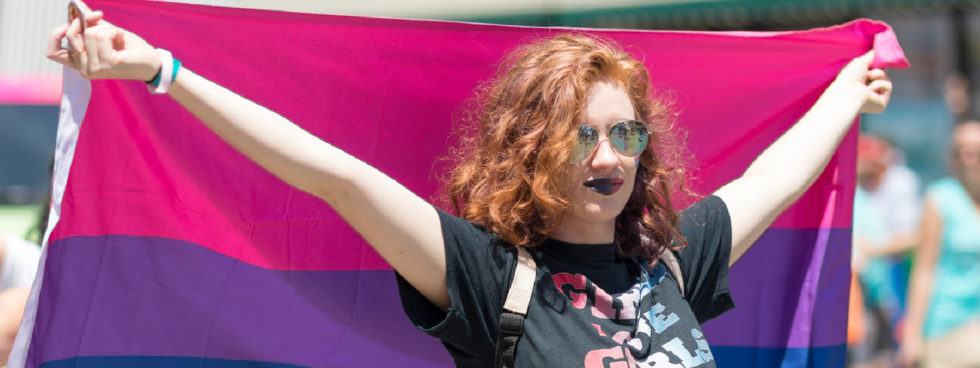happy bisexual awareness month!
September 23rd is the official Celebrate Bisexuality Day. We’re ready to wave our bi pride flag and celebrate all the bisexual babes that bring the ‘B’ to the LGBTQIA+ community.
Bisexuals make up 8% of the community, where as the Gay & Lesbian population makes up 3%. Even though they make up the majority of the queer population, there’s still a ton of misinformation floating around about bisexual people. So cuff your jeans and settle in, because we’re about to bust one of the most common myths about bisexuality…
bisexual means half gay + half straight
This is the biggest myth that plagues the bisexual community. Bisexuality isn’t as cut and dry as being attracted to people of the same gender and people of the opposite gender, equally. You can be more attracted to one gender, less attracted to another and your level of attraction can change at different times in your life.
Bisexuality also doesn’t mean being attracted to only cis men or women, it also includes attraction to non-binary and trans people. Bisexuality means being attracted to two OR MORE genders and encompasses all orientations.
why not just be pansexual?
Many people wonder why bisexual people don’t just switch to the label: pansexual.
pansexual |adjective|
pansexuality fits under the bisexual+ umbrella. It means an attraction to people regardless of gender. Even though pansexuality and bisexuality are very similar, it comes down to the preference of the individual as to what label they’d like to use.
Sexuality is very personal. What label works for one person, may not feel right to someone else. You can also use multiple labels, if that feels right for you. Even ones that may seem contradictory to some people.
For example, many people identify as bisexual lesbians, which has been a point of contention between the bi and lesbian community. But it’s not up to us to police other people’s sexual identities. Whatever they choose to identify as is their business. It’s our job to respect their choice.
To quote The Bisexual Manifesto, written in 1990:
“Bisexuality is a whole, fluid identity. Do not assume that bisexuality is binary or duogamous in nature: that we have “two” sides or that we must be involved simultaneously with both genders to be fulfilled human beings. In fact, don’t assume that there are only two genders. Do not mistake our fluidity for confusion, irresponsibility, or an inability to commit. Do not equate promiscuity, infidelity, or unsafe sexual behavior with bisexuality. Those are human traits that cross all sexual orientations. Nothing should be assumed about anyone’s sexuality, including your own.”
bisexuals are often stereotyped
Bisexual men are more likely to be categorized as gay, whereas bisexual women are more likely to be categorized as straight. For men, bisexuality is seen as a stop over before coming out as gay, for women it’s seen as a way to get attention or to ‘turn on’ their male partners. It’s interesting that, in both cases, we only accept sexuality if it’s being associated with the desires of men.
This is so common that there was even a study conducted in 2020 to see if bisexuality in males even exists. Newsflash…it does!
Bisexuals are also more likely to be fetishized. They’re often asked for threesomes or even rejected by potential partners because they think bisexual people are more likely to cheat.
Bisexual people are still…people. Their level of desire varies from person to person and they are just as likely to cheat as anyone else. Bisexuality doesn’t mean you can’t be in a monogamous relationship.
When people worry about their bisexual partner cheating on them, it’s often because they feel like they can’t “provide everything they want.” But this idea boils people down to their genitals and equates desire to what kind of junk someone has in their pants.
If someone is going to cheat on their partner, they’re more likely to be drawn by a mental or emotional connection than they are to their genitals.
the negative effects of bi erasure
No matter who they’re dating, bisexual people are always bisexual. If they’re in a relationship with someone of the same gender, it doesn’t mean that they’re suddenly gay. If they’re dating someone of the same gender, it doesn’t mean they’re suddenly straight. They are always bisexual.
For example, if two women are in a relationship and one is a lesbian and the other is bisexual, but they mostly hang out at lesbian community events, they may be referred to as a ‘lesbian couple.’ But this may not feel accurate or affirming for the woman who identifies as bisexual. If she brings this up, people in her community may diminish her feelings or tell her that her bisexuality doesn’t matter, now that she’s in a relationship with a woman.
This is referred to as bi erasure.
bi erasure |noun|
Bi erasure is when the existence of bisexuality is delegitimized or denied because people would rather put bisexuals into categories they better understand. It happens in real life as well as in our media representation. Bi erasure may seem insignificant to some, but it can lead to real consequences, like lack of resources and community support that is sorely needed in the bisexual community.
So, this September 23rd, while you’re celebrating all the beautiful bi babes in your life, remember that they’re still a long way to go when it comes to educating the world on common myths about bisexuals. Keep fighting the good fight and educate those around you, because bisexuality is so much more than the 50/50 split they make it out to be.

meet the author…
Jennifer Doan is a Confidence Coach, writer and orgasmic activist. She is on a life-long mission to help feminists own their sexual confidence by amplifying pleasure and giving less fucks. She believes virginity and gender are social constructs, sexuality is as fluid as her iced coffee and that EVERYONE deserves to feel empowered by sex.


